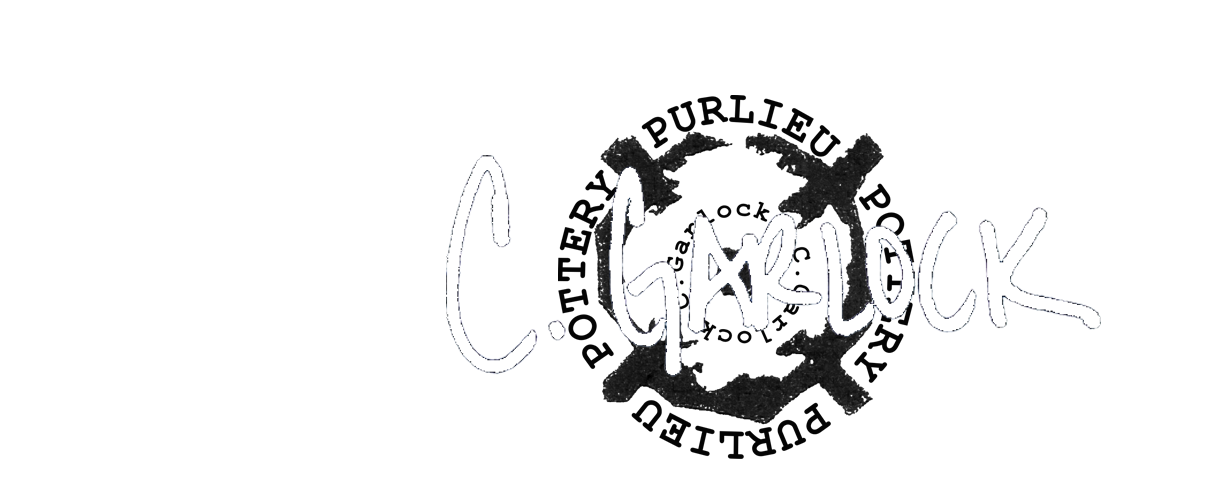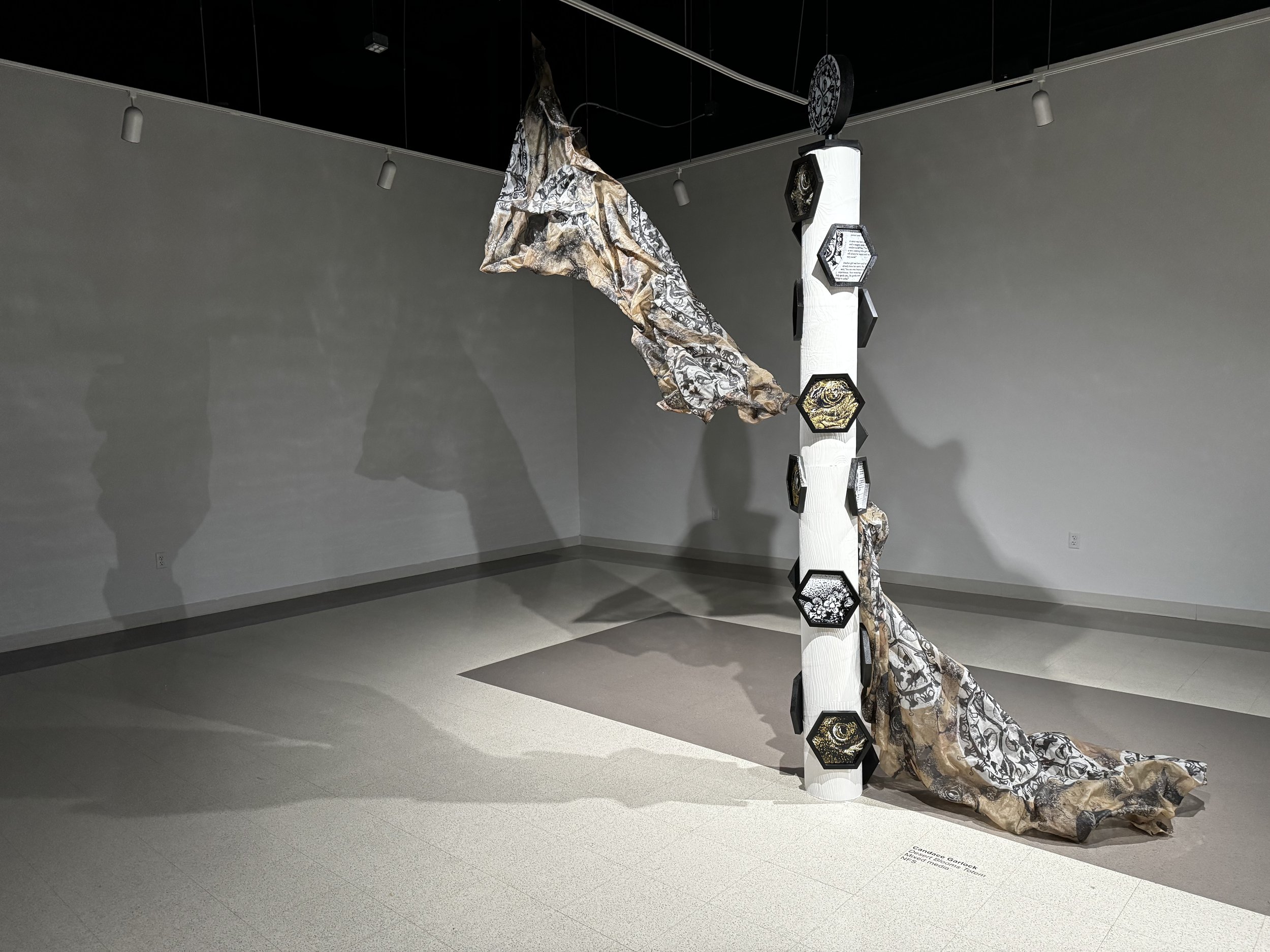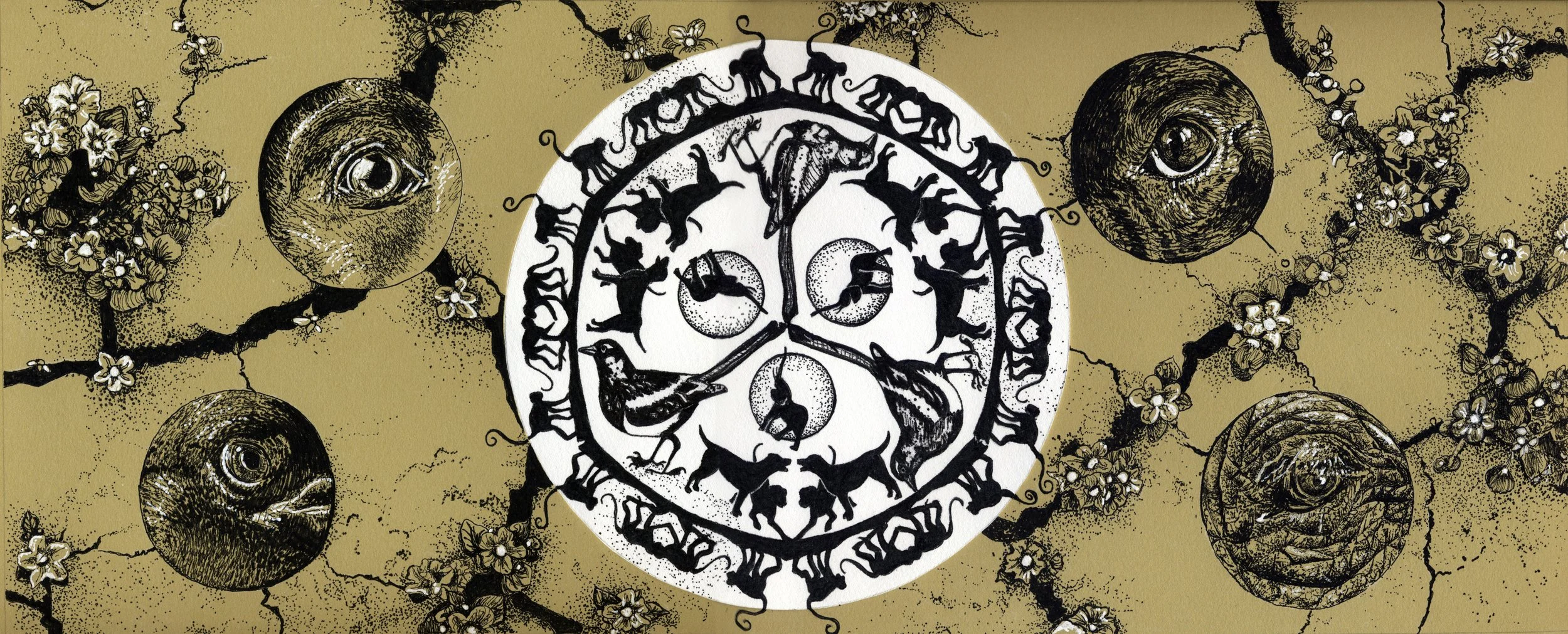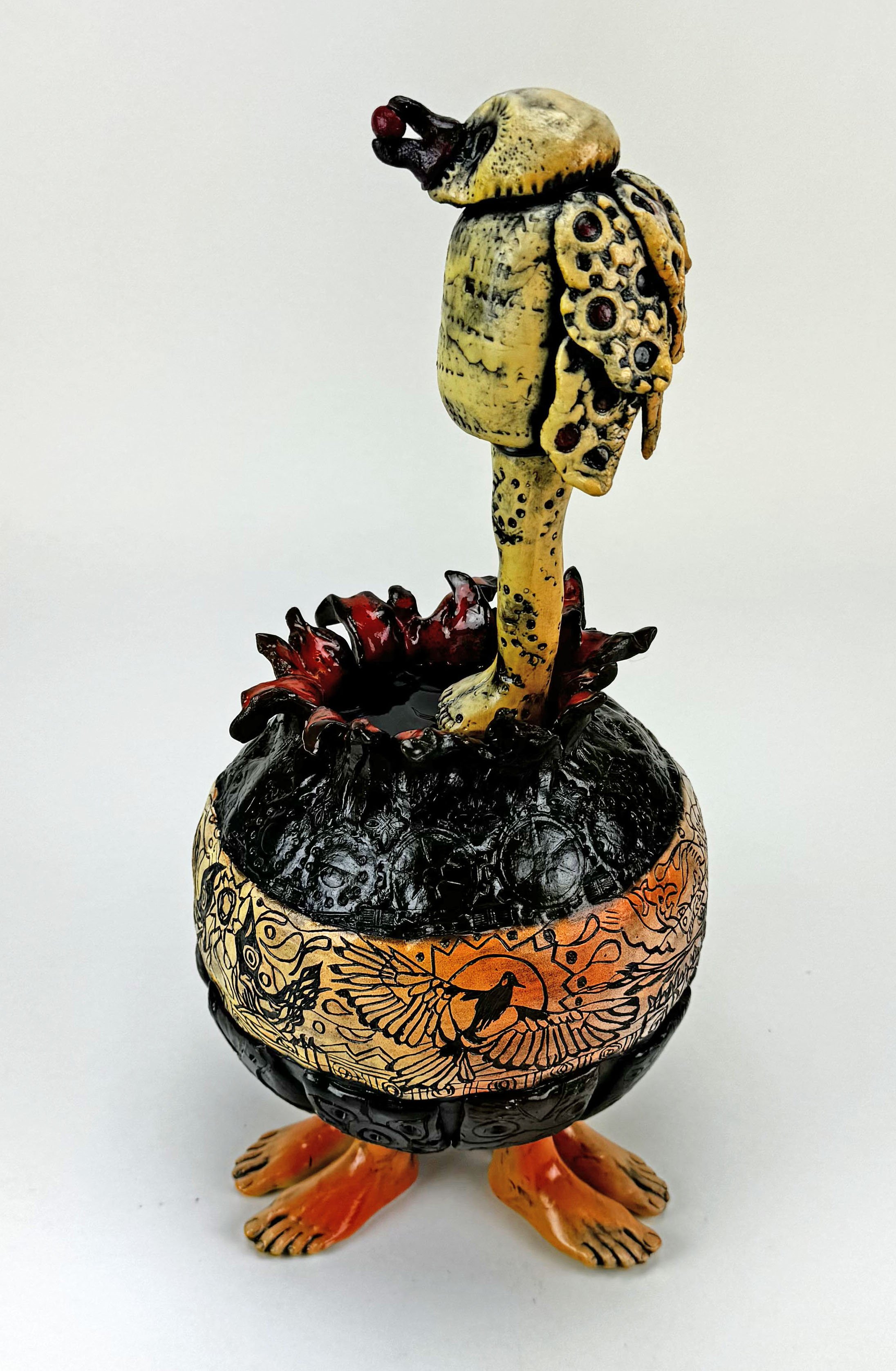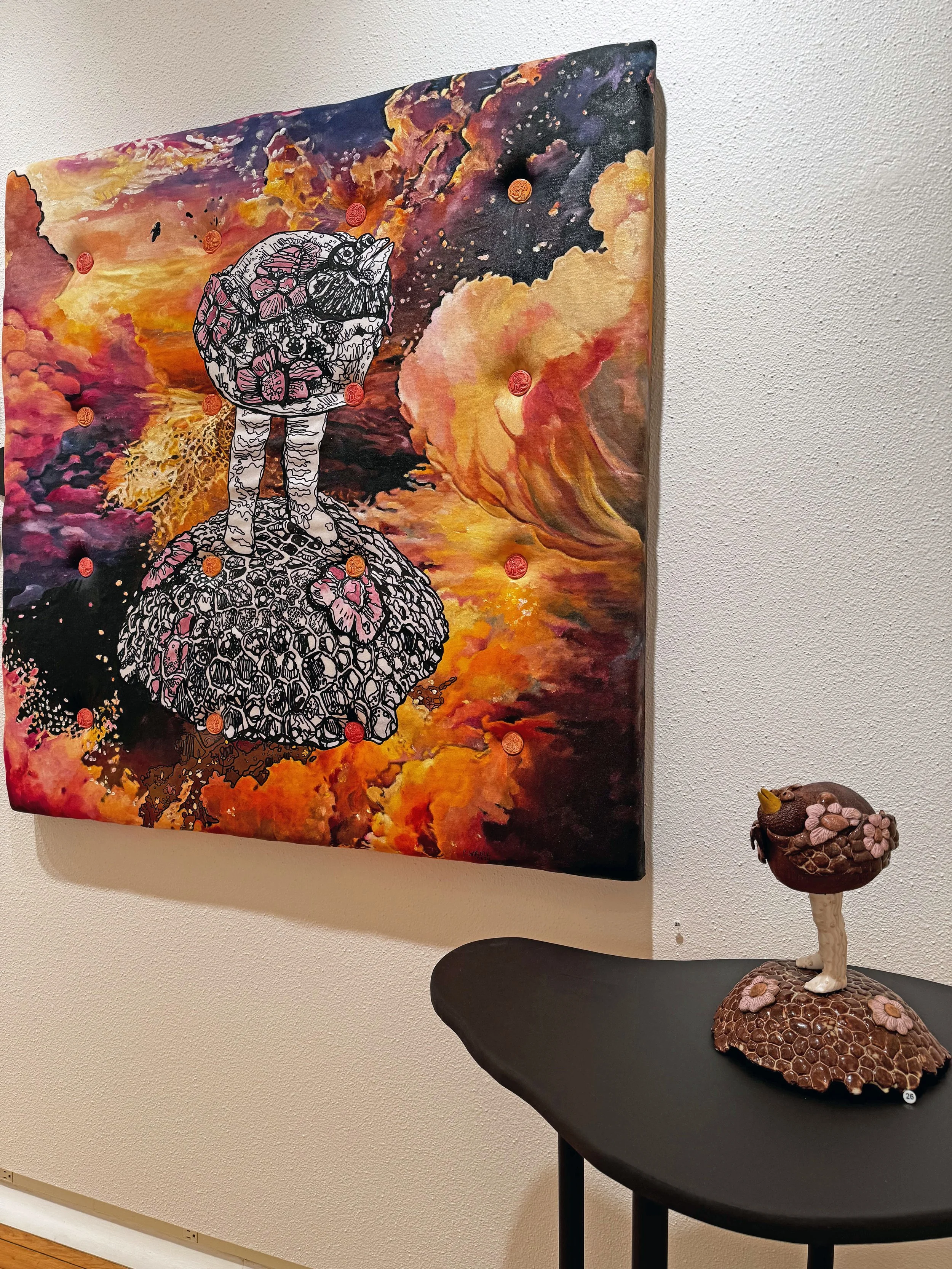TRANSFORMATIONS: Candace Garlock and The Animal Spirit
By David Gibson
Candace Nicol Garlock is an artist for whom the innately human, in appearance and symbol, is of primary importance. Over the duration of her career she has traveled through many stages and interpretations of what it means to be human, starting with interpretive paintings of the male nude body, inspired by a desire to explore the idea of the female gaze, and slowly she has moved into symbolic territories that focus upon the connection between humans and animals. Animals appear more progressively in her work, representing not only a spiritual world or a notion of otherness, but as a means of accessing greater connections with our own nature.
Totem sculpture inspired by Desert Blooms, TMCC Wedge Outside the Box exhibit "Totems and Family" 2024
We are instinctively connected to the world. Yet our modern life is a radical disjuncture from this instinct, and has been since at least the beginning of the Industrial Revolution. Societal changes, accompanied by political upheaval and ruptures in the social fabric, have led to a change of mind in which Nature no longer nurtures us. Humanity moved inexorably toward technology and a reorganization of the social order. Cities dominated. If we engaged with nature, it was as pets, or as animals in the zoo. Our psychic connection to nature itself was lost. The possibility of realizing a symbolic aspect in our lives often occurs in tandem with periods of crisis–sadness, isolation, and general malaise or depression–when the standard expectations seem under attack by previously unknown forces. The search for the symbolic is a means of assuaging uncertainty and establishing a charismatic order where none existed before. Garlock investigates symbolic territories that synthesize human aesthetics with animal instincts. Animals represent a spirit world that has infiltrated modern living through, in her case, expressions of affection given to small children, in which each child is given a nickname corresponding to the impressions adults have of their emotional condition and general behavior. Garlock bestowed each of her four grandchildren with animal nicknames—and therefore, spirit animals—in consistent order with how she perceived them: Mason Monkey, Maddox Mad Dog, Maddie Magpie and Emsley Elephant. Through the scrim of charming characteristics each name bestows, the reference to animals alternates as a categorical order already present in Garlock’s mind, specifically her unconscious, and the degree to which this naming event further reinforces her relationship to all four such spirits—or as we like to call them, archetypes.
Original Drawing (pen and ink)for print project: Desert Blooms thy heart, pen and ink on Rives BFK paper, 8'x20" 2018
Mythical creatures persist in the popular imagination mainly through books and films, yet the fact is that all animals have some identity in myth making, even those who are in all respects normal in appearance. The particular magic of animals is connected to their otherness; to our tendency to perceive them as connected to a spiritual realm. Since they are essentially non-human their identity must originate from another place than our own, and their purpose as different types of animals, birds, and fish, must likewise contain a symbolic character that can add value to our lives. Garlock’s work maintains a strong connection to animals that began with her Hum/Animals series in 2018. It appears repeatedly in nearly all of her subsequent series such as Bird Chatter: The Rise of the Fashionistas and The Pink Collection; A New Day and The Pollinators Series; and Stillwater Imaginings. Each of these series takes the idea of a humanized animal, or animalized human, and places them into progressively complex scenarios and universes in which they may take on the mantle of a heroic figure. Hum/Animals, which originated in Garlock’s traditional medium or printmaking, establishes the most universal and quotidian system of figurative embodiments. “Desert Blooms thy heart” presents a printed image of four different animals, each hailing from a different habitat and range of metaphoric association, are organized into a mandala design that, in its own manner, arranges a world according to our immediate impressions. The conception of the mandala is to create if not an actual map, a tree of descendant or equilateral relationships among the forms from which it is comprised. The shape of the mandala is like a planetary system, and each form—in the case, a monkey, a dog, a bird, and an elephant—depicts a relational value system that is idiosyncratic despite seeming universal. Its innate meanings are contained in the variety and number of figures. and the placement of each from the center of the mandate to its edges. Her mandala is structured into three equal areas, with fault lines creating boundaries between them leading into mystery, and with planar middle areas being adorned with spheres containing elephants. The fault lines that divide these areas leads to double sized images of magpies; and then passing through them, encircle the whole proximity of the planar areas with animals adorning both the inside and outsides edges of the borders: the dogs inside the lines, and the monkeys in groups assembled upon the outer edge. While it’s uncertain what sort of categorical order into which each animal is placed, or whether their locations were merely determined by a relational strategy that connects back to her grandchildren’s socially arranged hierarchies, the image as a whole carries a strong undercurrent of portent.
Stillwater Fashioinista “Tia” Stillwater Fashionista “Tia” Ceramic, Resin 8”Hx8”Wx8”D 2024
Of these images, Garlock seems to have connected the most intensely with birds. These kinds of animals operate within their own sphere, and insofar as they, not being mammals, they embody a distinct quality of otherness. Usually admired for their plumage and seasonal instincts, we have an access to them, and extend a degree of humanism toward them as a consequence of our desire to project human values into their world. Birds occupy a range of symbolic timbre. From Native American folklore to tales and fables as parables of a moral universe, to cartoon and puppet figures, bids are everywhere in our culture. Garlock takes a bird form that seems cartoonish and infers a quality of pathos, like the humble protagonist at the center of a picaresque narrative like Candide by Voltaire. The hero of this decidedly antiheroic tale must be in some ways a simpleton, or outwardly innocent and uninformed, so that his judgements can be trusted. The figure, or type of figure, who plays the protagonist in her Bird Chatter series looks like he emerged from a nightmare. Despite seeming innately strange he does not have anything about him that is dangerous; instead, he inspires pity. He has doglike large eyes, and a round figure that resembles a grapefruit more than any known living bird except possibly a plump fowl. Different versions of him have wings, no wings, armor or scales. The birds are sculpted in clay, and given doll legs, emerging from the depth of her studio practice fully formed, bejeweled, and filled with humanistic presence. They are fashionistas because they exemplify a body politic connected to “girly feminism” — fashionable prettiness that is girlishly innocent yet aiming to make a sophisticated impression upon the larger world. These girl birds are paragons of stylishness despite their a peverse roundedness whose esthetic harkens back to a primordial model like the Venus of Villendorf. Each example in the series, titled with joyful escapism, The Pink Collection, expands the ways in which they can be interpreted. With “Bird Chattter and The Rise of the Fashionistas,” the animal forms that at first emerged with her HumAnimals series becomes fully their own. They leave the page, so to speak, and take on a sense of agency, and a sense of fanciful sublime that continues to manifest in future series of the artist, preceding into ever more complex and beautiful contexts and adventures.
Mala Ceramic Sculpture 13”High x 9”Deep x 9”Wide 2024
FOR THE BIRD SERIES “Sunshine” Ceramic Bird Sculpture Cone 06 Earthenware, acrylic. Base Porcelain pour over sunflower head 9”H x 9”W x 9”D 2023
Hope Springs – Stillwater Imaginings Acrylic, foam, ceramic buttons 48”x48”x3” 2024 and FOR THE BIRD SERIES “Spring” Ceramics Cone 5 recycled clay and porcelain sculpture 12”Hx9”Wx9”D 2022
Bird Chatter Prints: Relief Linoleum Cut on on Legion Somerset Archival Paper 18”x18” (22”x22” Framed) 2023-2024 Shown at Oats Park Art Center, Fallon, NV as part of the Pollinators: Gift of Chance in the Desert exhibition, 2024.
Garlock is an artist on the move. Her conditional reflexes produce diverse forms that consistently hew to concern for the human, for its vulnerabilities as well as its strengths, and for the merging of consciousness between intellect and instinct, out of which a native intelligence is constantly being born. The creative mind operates well under duress. Hers has produced a fanciful everyman whose identity–whether man or animal–is dictating a wider and more sublime universe for it to inhabit, and for Garlock to share with us. Her generosity is to our benefit.
Candace Garlock, Reno Tahoe International Art Show, 2024
DAVID GIBSON is a New York based arts journalist and agent. He grew up within the art world with family ties and has developed his critical acuity between an understanding of theory and the real lives of professional working artists. He has written for Zingmagazine, Performing Arts Journal, C magazine, Art Notes, Flash Art, and Frieze to name a few. Since 2021 he has published his email newsletter The Other Side of the Desk on Substack.
